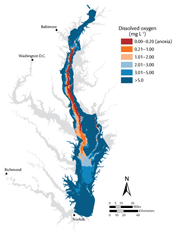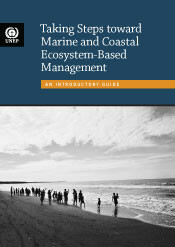Job Vacancy: Estuarine Response Data Analyst
The goal of the position is to provide analysis support for the diagnosis of the natural conditions and anthropogenic-based reasons behind the observed current status and long-term trends in tidal Chesapeake Bay basin water quality conditions. The position will be responsible for assessing the effectiveness of management actions based on long-term observed responses within the estuarine and the surrounding watershed ecosystems. The position will involve providing leadership by organizing and coordinating teams drawn from the larger regional scientific and management community. These teams will be charged with the responsibility of synthesizing data, analyzing results, and developing information for effective communication products focused on resolving the scientific and technical aspects of a select set of issues relevant to the management on an annual basis.2010 Maryland Coastal Bays report card
 The aim of this report card is to provide a transparent, timely, and geographically detailed assessment of 2010 Coastal Bays health. Coastal Bays health is defined as the progress of four water quality indicators (TN, TP, Chl a, DO) and two biotic indicators (seagrass, hard clams) toward scientifically derived ecological thresholds or goals. The six indicators are combined into one overarching Coastal Bays Health Index, which is presented as the report card score. Detailed methods are available at https://ecoreportcard.org/report-cards/maryland-coastal-bays/health/. The overall score for the Coastal Bays was a C in 2010. All regions declined in overall health when compared to 2009.
The aim of this report card is to provide a transparent, timely, and geographically detailed assessment of 2010 Coastal Bays health. Coastal Bays health is defined as the progress of four water quality indicators (TN, TP, Chl a, DO) and two biotic indicators (seagrass, hard clams) toward scientifically derived ecological thresholds or goals. The six indicators are combined into one overarching Coastal Bays Health Index, which is presented as the report card score. Detailed methods are available at https://ecoreportcard.org/report-cards/maryland-coastal-bays/health/. The overall score for the Coastal Bays was a C in 2010. All regions declined in overall health when compared to 2009.
2011 Chesapeake Bay dissolved oxygen forecast
 For the past several years, Chesapeake Bay scientists have collaborated with EcoCheck to forecast summer dissolved oxygen conditions, based on flow and nutrient loading conditions through May. The 2011 anoxia forecast is supported through research at Johns Hopkins University, Old Dominion University, UMCES-Horn Point Lab, and the Chesapeake Bay Program. This forecast uses the same basis as previous anoxia forecasts—nitrogen loads—but adds other elements that may provide a better understanding of anoxia in the mainstem Bay. The forecast was divided into early summer and late summer predictions because for the past several years there has been a noticeable change in anoxic volume following wind events in late June and early July. The early summer anoxia forecast predicts moderate to poor conditions, based on nitrogen loads from January to April as well as high flow in May.
For the past several years, Chesapeake Bay scientists have collaborated with EcoCheck to forecast summer dissolved oxygen conditions, based on flow and nutrient loading conditions through May. The 2011 anoxia forecast is supported through research at Johns Hopkins University, Old Dominion University, UMCES-Horn Point Lab, and the Chesapeake Bay Program. This forecast uses the same basis as previous anoxia forecasts—nitrogen loads—but adds other elements that may provide a better understanding of anoxia in the mainstem Bay. The forecast was divided into early summer and late summer predictions because for the past several years there has been a noticeable change in anoxic volume following wind events in late June and early July. The early summer anoxia forecast predicts moderate to poor conditions, based on nitrogen loads from January to April as well as high flow in May.
Taking Steps toward Marine and Coastal Ecosystem-Based Management - An Introductory Guide
 Healthy marine and coastal ecosystems provide valuable services, from food security, resources for economic growth and recreation to tourism and coastline protection. Published by the United Nations Environment Programme (UNEP), this guide on Marine and Coastal Ecosystem-Based Management (EBM), seeks to assist countries and communities to take steps towards making marine and coastal ecosystem-based management operational, from strategic planning to on-site implementation. It outlines operational considerations in an accessible language, drawing upon practical experiences and lessons across the globe, from tropical coastlines to temperate estuaries and polar ocean ecosystems.
Healthy marine and coastal ecosystems provide valuable services, from food security, resources for economic growth and recreation to tourism and coastline protection. Published by the United Nations Environment Programme (UNEP), this guide on Marine and Coastal Ecosystem-Based Management (EBM), seeks to assist countries and communities to take steps towards making marine and coastal ecosystem-based management operational, from strategic planning to on-site implementation. It outlines operational considerations in an accessible language, drawing upon practical experiences and lessons across the globe, from tropical coastlines to temperate estuaries and polar ocean ecosystems.
Assateague Island National Seashore Natural Resource Condition Assessment
 Assateague Island National Seashore with lands and waters in Maryland and Virginia receives some two million visitors per year. After determining key habitats on Assateague Island, potential indicators were identified and data sourced. Attainment of reference condition was assessed for each metric and summarized by habitat and ultimately for the whole park. Based on these key findings, management recommendations were developed. Overall, the natural resources of Assateague Island National Seashore were assessed to be in fair condition. While salt marsh, forest and shrubland habitats were assessed to be in degraded condition, inland wetlands, dunes and grasslands were assessed as fair, bay subtidal and mudflats, beach and intertidal to be in good condition and Atlantic subtidal to be in very good condition.
Assateague Island National Seashore with lands and waters in Maryland and Virginia receives some two million visitors per year. After determining key habitats on Assateague Island, potential indicators were identified and data sourced. Attainment of reference condition was assessed for each metric and summarized by habitat and ultimately for the whole park. Based on these key findings, management recommendations were developed. Overall, the natural resources of Assateague Island National Seashore were assessed to be in fair condition. While salt marsh, forest and shrubland habitats were assessed to be in degraded condition, inland wetlands, dunes and grasslands were assessed as fair, bay subtidal and mudflats, beach and intertidal to be in good condition and Atlantic subtidal to be in very good condition.

